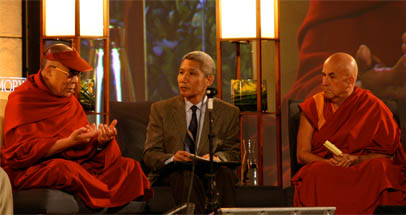Last week in Atlanta, Buddhist scholars and researchers in psychology, psychiatry, and neuroscience congregated alongside His Holiness the Dalai Lama for Emory University’s Conference on Compassion Meditation. The conference explored several of the many methods for constructively dealing with destructive emotions that Buddhism offers. HHDL contended that these negativity-reducing methods could be practiced in a secular context by Buddhists and non-Buddhists alike. During the conference, participants from different fields presented convincing research demonstrating the benefits of compassion meditation among a variety of non-Buddhist populations.
Particularly interesting in the conversations were the recurrent attempts to articulate the distinction between empathy and compassion. Psychologist and primate researcher Frans B.M. de Waal began this conversation by identifying empathy as an automated, involuntary, biologically-inbuilt reaction. He contrasted the reactive component of empathy with the predominantly cognitive dimension of compassion or “self-aware sympathy” exhibited only in animals capable of mirror self-recognition.
The correlation of the distinguishing between self and other and the potential to experience compassion immediately reminded me of the “space-creating” rhetoric of compassion meditation, where it is said that compassion “creates space”—between the practitioner and suffering of another (or even one’s own suffering)—that allows the person to deal with suffering rationally and constructively.
Later, neuroscientist Richard Davidson presented findings suggesting that empathy and compassion correlate to differing neural states. He found that the circuits engaged by compassion training partially overlap with those activated during empathy, but differ in that they also involve the dorsomedial prefrontal cortex, which he suggested might play a role in expressing and enacting aspiration. Such would accord with the Buddhist definition of compassion—the aspiration that others be free from suffering. 
Matthieu Ricard, western monk, scientist, and author, continued the conversation, considering how the experience of empathy without compassion would induce incredibly unpleasant, even crippling, states. The following day, Matthieu explained the testing of this hypothesis in the lab, where seasoned meditators were instructed to resonate with others’ suffering without generating compassion or performing cognitive reappraisal until the practice became utterly unbearable—and it did. When the meditators in the lab then generated compassion, their experience transformed completely. These meditators had trained extensively in generating compassion in the face of suffering almost immediately, but teasing apart empathy and compassion in the lab proved to be extremely illuminating.
Empathy that resonates with another’s painful condition causes the empathizer to experience that same suffering, which can easily overwhelm. Training in compassion can transform the same empathy that in itself is debilitating into a helpful force.
As HHDL reiterated, we need to take into account the differences between the reaction caused by witnessing pain and the helpful attitude of compassion, which understands the causal conditions that lead to suffering.
This event was part of His Holiness the Dalai Lama’s visit to Emory University, coinciding with the International Conference on Tibetan Buddhism. Check out Tricycle’s summary of the events here.
Thank you for subscribing to Tricycle! As a nonprofit, we depend on readers like you to keep Buddhist teachings and practices widely available.